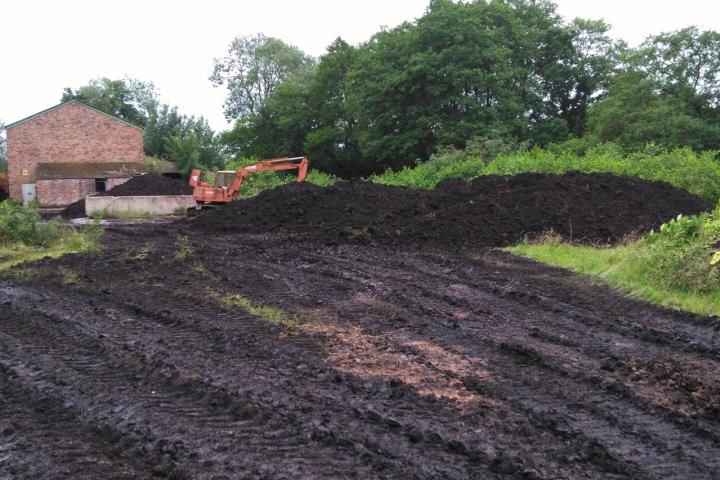
On Wednesday, 6th May, wilmslow.co.uk printed an article headed Cheshire East Council Agrees Carbon Neutral Plan. One of the proposals was to provide opportunities to capture carbon through tree planting and restoring degraded peatlands. Very credible.
Forward to Sunday, 7th June and Saltersley Common Preservation Society (SCPS) wrote a letter to the website headed 'Continuing problems on the peat bog'. These problems have resulted in the loss of oak trees along Rotherwood Road which borders the bog to the east. Our hydrogeologist and arboroculturalist have put this down to the continued dewatering of the bog. What a shame no-one from Cheshire East Planning Department has taken time to read these articles.
On Monday, 29th June, heavy duty machinery appeared on the bog and started moving large quantities of peat to the yard. When challenged, a representative from Croghan Peat told us it wasn't really peat and that this was the start of the restoration process.
A quick check of the conditions applied when the application for housing was granted in December 2018 showed that Condition 31 had been ignored. Briefly, this says that before any restoration work starts a Water Vole Protection Scheme must be submitted to the MPA and approved in writing.
Three emails to CE planning department and we got the quick response that this hadn't been received. A further question about the restoration plan elicited the reply that this hadn't been received either.
SCPS were not surprised by any of this as it was a familiar story. In 2003, when the then CCC and Croghan agreed the original set of conditions for peat extraction, the Water Vole Protection Scheme was submitted then totally ignored. And why is the bog still subsiding? Because the Sluice Control Structure and Settling Pond Scheme,also in the conditions, were never discharged either.
And where is the worst of the subsidence and the falling trees occurring. Alongside Rotherwood Road where the peat is now being taken away with the knowledge of CEC.
CEC still claim that the peat is being taken removed for analysis before restoration starts. Absolute tosh. The peat taken away (which isn't really peat) should have been put back in the ditches it was taken from (see every re-wetting scheme). And if CEC had examined documents SCPS have submitted over the years they should have seen the report showing the peat to be of poor quality anyway. And that peat was sent to The Soil Association in a small box, not huge lorry loads.
Apart from releasing huge quantities of CO2 into the air, the subsidence will worsen and more trees are at risk. Currently, Newgate Kennels and The White House are pursuing legal claims against Croghan Peat although there can be no doubt that CEC must take some blame for allowing the situation to worsen.
Responsibility for the restoration and aftercare must be taken away from CEC and put in the hands of experts before there is nothing left to save. They have proved their incompetence.
Photo: Todays pile of peat. Are they going to put it back?









Comments
Here's what readers have had to say so far. Why not add your thoughts below.
https://www.gov.uk/government/publications/national-planning-policy-framework--2
Page 58
204. Planning policies should: a) provide for the extraction of mineral resources of local and national importance, but not identify new sites or extensions to existing sites for peat extraction;
page 59
205. When determining planning applications, great weight should be given to the benefits of mineral extraction, including to the economy. In considering proposals for mineral extraction, minerals planning authorities should:
.....
d) not grant planning permission for peat extraction from new or extended sites;
Cheshire East Local Plan Strategy
https://www.cheshireeast.gov.uk/pdf/planning/local-plan/local-plan-strategy-web-version-1.pdf
Page 148
Policy SE 10
Cheshire East will make provision for an adequate and steady supply of minerals in support of sustainable economic growth without unacceptable adverse impacts on the environment having considered the need to conserve finite natural resources as far as possible and safeguard them for future generations. To achieve this, the council will:
9. Not support proposals for peat extraction from new or extended sites
Page 149
13.103 To enable the provision of a steady and adequate supply of both aggregate and industrial minerals, allocations in the form of specific sites, preferred areas and/or an area of search for potential future minerals development will be identified through the Site Allocations and Development Policies Document. This approach to allocations is considered to offer a level of certainty as to where potential mineral extraction may take place, whilst providing a degree of flexibility to meet needs over the plan period. This will involve reviewing existing allocations in the Cheshire Replacement Minerals Local Plan 1999. New allocations will be subject to necessary environmental assessment and sustainability appraisal. New sites, or extensions to existing sites for future peat extraction, will not be included consistent with national planning policy.
Page 151
13.112 Proposals for the extraction of peat at new or extended sites in Cheshire East, will not be supported, reflecting the national planning policy position on peat extraction.
The Cheshire Replacement Minerals Local Plan
https://www.cheshireeast.gov.uk/pdf/planning/spatial-planning/strategic-planning/en-ldf-crepmlp-99.pdf
This text below is concerned with extraction of minerals whilst balancing environmental resources.
Page 56
8.16 There is now a growing awareness of the importance of peatlands and the value attached to them, as identified by the Governments planning guidance. They are recognised as being of importance and of high nature conservation value, supporting a range of specialised wetland flora and fauna. This is reflected by the statutory designation of some peat areas as SSSIs, SBIs and Ramsar sites.
8.17 As well as being of nature conservation importance and a potential mineral resource areas of peat offer potential for a variety of other uses. These uses form alternative competing demands on the peat areas.
Page 57
iv Carbon sinks - Undisturbed peatlands store large amounts of carbon. The drainage of peatlands promotes the oxidation of this carbon which is seen as a greenhouse gas. The extraction of peat and the afforestation of these areas also increases oxidation.
Page 58
8.24 The Government intends that the future extraction of peat in England from any new sites should be restricted to areas which have already been significantly damaged by recent human activity and are of limited or no current nature conservation or archaeological value and are not constrained by other land-use policies. Wherever possible, restoration of sites should give priority to wetland rehabilitation and to the enhancement of nature conservation.
POLICY 49 Peat The County Council will not permit applications for the exploration or winning and working of peat from peatlands which retain a high level of nature conservation or archaeological interest.
I am surprised by the lack of response from residents of houses in the catchment area. Subsidence is a costly issue.
a) Although this area is used by the community it is actually private land. It is owned by Croghan Peat Ltd and has a market value reputed to be £3.5 million. This value is largely reflective of the planning permission granted in 2018 to build 14 houses on the site. Therefore, Cheshire East does not control this land and any public consultation about how the bog should be restored is at the discretion of its owners.
b) Saltersley Common Preservation Society (SCPS) are heavily involved with the legal case to claim subsidence damages from Croghan Peat Ltd. The Local Government Ombudsman investigated these subsidence claims in 2012 and found there was no evidence to support them. However, they did criticise the council for other matters regarding this site though and the subsidence claims against Croghan Peat Ltd are still ongoing. I don't know the full merits of this investigation or claim but I do think it demonstrates a long and ongoing dispute that makes it highly unlikely Croghan Peat Ltd will want SCPS to be actively involved in how the land is restored.
c) Permission to extract peat on this site was first granted in the 1950’s and this permission runs until 2042. Cheshire East monitors this activity in its capacity as the Minerals Planning Authority (MPA). The peat extraction has now stopped because they have basically dug out all the peat they can and are not allowed to dig any deeper. However, I don't believe this stops them driving mining vehicles onto their land and removing any surface peat that is still there though. I understand from my fellow councillor Iain Macfarlane who visited the site today that they are levelling off the site by moving the peat bunds (mounds) to the part of the land where the houses will be built.
d) Installation of the sluice gates was not enforced because the relevant agencies at the time thought that installing them could harm the water voles, which would be illegal. Since 2016, the council has worked with its Nature Conservation Officer, the Environment Agency and Croghan Peat Ltd to increase the amount of work undertaken to maintain the ditches and the environment for the water voles. Whether the future restoration work includes building the sluice gates is not yet decided.
e) In 2018, Cheshire East gave planning permission to build 14 houses on this site but only if the peat bog was also restored. The planning permission for the restoration has many conditions, which includes Water Vole protection that Tony mentions. However, these conditions only come into play when the house building starts. They are not the rules for the activity on this site beforehand though. Therefore, Cheshire East Planning has not ignored these conditions. It is just that they cannot enforce them until they are activated by the start of the house building. Cheshire East is monitoring this current work to ensure it complies with all other legal requirements though.
f) After consulting with Croghan Peat Ltd they say this current activity is to define what restoration work is needed. This will be agreed by Cheshire East and they want to start the restoration work later this summer along with the house building too. However, I cannot verify their future actions, so must take their word on this but understand why many people are sceptical of their promises.
g) Cheshire East will agree the restoration plan and monitor any work to ensure it is properly completed. Although I will try and share as much information as possible, Cheshire East has to respect Croghan Peat Ltd’s right to decide how much they want the community to be involved in this process.
Therefore, I think we should view the current activity on the site with cautious optimism. We have to wait for the restoration plan to be submitted but it does seem like a significant step forward. Hopefully, the years of tireless campaigning by people like Tony Evans and Transition Wilmslow will now pay off and once again the town can enjoy this area in its most natural state possible.
Cllr Mark Goldsmith
Residents of Wilmslow
Wilmslow West & Chorley ward for Cheshire East & Wilmslow Town Council
Time for CEC to spend our money on something we want; rather than on compensation to failed and suspended officers; public enquiries into elected Councillors shortcomings (only to have the report we paid for totally censored) and many more failings documented in the National Press.
I have a feeling that the subject might appear soon in Private Eye, which would be a shame.
Time for the new regime at CEC to “step up to the plate” kick off excuse-making and adopt a strategy with extraction company befitting those with right on their side... which we have.
To all those who have the intelligence, energy, resources to resist destruction of precious, irreplacable, life enhancing environments - us lesser mortals salute your endeavours - thank you.